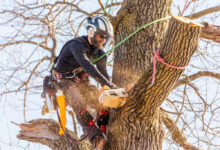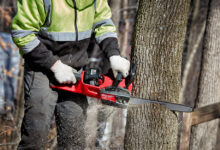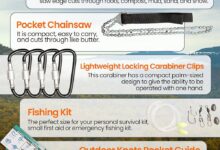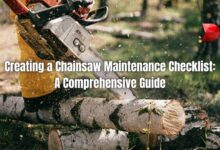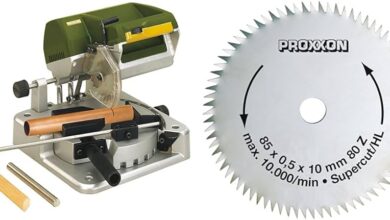Contents
Introduction
Chainsaws are powerful tools that can be used for a variety of tasks, including cutting down trees, trimming branches, and clearing land. However, chainsaws can also be dangerous, so it is important to use them safely and properly. If you are new to chainsawing, it is best to start with small branches. Here are a few tips to help you get started:
1. Choose the right chainsaw. For small branches, you will need a chainsaw with a bar length of 14 to 18 inches. The bar length is the length of the guide bar, which is the metal bar that holds the chain. A shorter bar length is easier to control, which is important when you are cutting small branches.
2. Wear the proper safety gear. When using a chainsaw, it is important to wear the proper safety gear. This includes a hard hat, safety glasses, ear protection, gloves, and chaps. Chaps are protective pants that are made of a cut-resistant material.
3. Start the chainsaw properly. Before you start the chainsaw, make sure that the chain brake is engaged. The chain brake is a safety feature that stops the chain from rotating if it kicks back. To start the chainsaw, hold it firmly with both hands and pull the starter cord.
4. Hold the chainsaw correctly. When holding the chainsaw, keep your hands firmly on the handles and your feet shoulder-width apart. Keep your elbows slightly bent and your back straight. This will help you to maintain control of the chainsaw.
5. Cut with the grain. When cutting branches, it is important to cut with the grain. The grain is the direction of the wood fibers. Cutting with the grain will help to prevent the chainsaw from binding and kicking back.
6. Be aware of your surroundings. Before you start cutting, make sure that there are no people or objects in the area. You should also be aware of any overhead wires or other hazards.
7. Take breaks. Chainsawing can be tiring, so it is important to take breaks. This will help you to stay focused and avoid accidents.
Strengths and Weaknesses
Here are some of the strengths and weaknesses of chainsawing small branches:
Strengths:
- Chainsaws are powerful tools that can quickly and easily cut through small branches.
- Chainsaws are relatively easy to use, even for beginners.
- Chainsaws are portable, so you can easily take them to where you need them.
Weaknesses:
- Chainsaws can be dangerous if they are not used properly.
- Chainsaws can be expensive to purchase and maintain.
- Chainsaws can be noisy and produce a lot of vibration.
Table of Information
The following table provides a summary of the key information about chainsawing small branches:
| Feature | Description |
|—|—|
| Bar length | 14 to 18 inches |
| Safety gear | Hard hat, safety glasses, ear protection, gloves, chaps |
| Starting procedure | Engage chain brake, hold firmly, pull starter cord |
| Holding position | Firmly on handles, feet shoulder-width apart, elbows slightly bent, back straight |
| Cutting technique | Cut with the grain |
| Safety precautions | Be aware of surroundings, take breaks |
| Strengths | Powerful, easy to use, portable |
| Weaknesses | Dangerous if not used properly, expensive, noisy, vibrates |
Frequently Asked Questions
Here are some of the most frequently asked questions about chainsawing small branches:
Q: What is the best way to start a chainsaw?
A: Hold the chainsaw firmly with both hands and engage the chain brake. Pull the starter cord with a quick, steady motion.
Q: How do I hold a chainsaw correctly?
A: Keep your hands firmly on the handles and your feet shoulder-width apart. Keep your elbows slightly bent and your back straight.
Q: What is the best way to cut with a chainsaw?
A: Cut with the grain and be aware of your surroundings. Take breaks to stay focused and avoid accidents.
Q: What are the safety precautions I need to take when using a chainsaw?
A: Wear the proper safety gear, be aware of your surroundings, and take breaks.
Q: What are the strengths and weaknesses of chainsawing small branches?
A: Chainsaws are powerful, easy to use, and portable. However, they can be dangerous if not used properly, expensive, noisy, and vibrates.
Q: What is the best way to maintain a chainsaw?
A: Clean the chainsaw after each use, sharpen the chain regularly, and replace the spark plug and air filter as needed.
Q: What are some common mistakes to avoid when chainsawing small branches?
A: Cutting against the grain, not wearing the proper safety gear, and not being aware of your surroundings are common mistakes to avoid.
Q: What is the best way to transport a chainsaw?
A: Transport a chainsaw in a secure case or scabbard.
Q: What are the different types of chainsaws?
A: There are two main types of chainsaws: electric and gas-powered.
Q: What is the best way to choose a chainsaw?
A: Consider the size of the branches you need to cut, the frequency of use, and your budget when choosing a chainsaw.
Q: What are the different safety features on chainsaws?
A: Common safety features on chainsaws include chain brakes, anti-kickback bars, and hand guards.
Q: What is the best way to learn how to use a chainsaw?
A: Read the owner’s manual, watch video tutorials, and practice in a safe environment.
Conclusion
Chainsawing small branches can be a quick and easy way to clear land, trim trees, and perform other tasks. However, it is important to use a chainsaw safely and properly. By following the tips in this article, you can help to reduce the risk of accidents and injuries.
Remember to always wear the proper safety gear, be aware of your surroundings, and take breaks. With a little practice, you will be able to use a chainsaw safely and effectively.
Closing Words
Chainsaws are powerful tools that can be used for a variety of tasks. However, it is important to use them safely and properly. By following the tips in this article, you can help to reduce the risk of accidents and injuries.
If you are new to chainsawing, it is best to start with small branches. This will help you to get the hang of using a chainsaw and to develop good safety habits. Once you are comfortable with chainsawing small branches, you can move on to larger branches and more difficult tasks.


